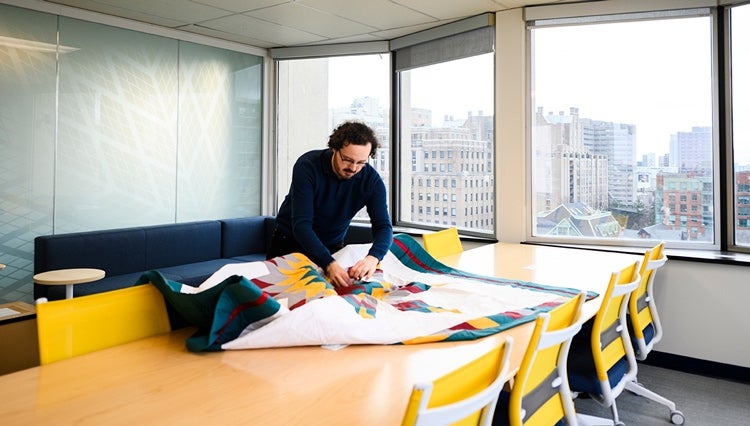Critical Health and Social Action Lab aims to advance Indigenous health justice

Founded by Associate Professor Jeffrey Ansloos, the Critical Health and Social Action Lab is engaged in a vast array of research projects that are community-based and directed by the communities themselves (photo by Christopher Katsarov Luna)
Published: February 7, 2024
For Jeffrey Ansloos, advancing Indigenous health justice means placing communities at the forefront of social action research.
A citizen of Fisher River Cree Nation, Ansloos is the founder of the Critical Health and Social Action Lab at the University of Toronto’s Ontario Institute for Studies in Education (OISE).
The lab comprises more than 30 researchers – from graduate students to community researchers and international collaborators – who are making strides in mental health research and suicide prevention.
“We engage in social action research that is led, shaped and designed by the priorities of Indigenous community partners,” says Ansloos, an associate professor in OISE’s department of applied psychology and human development who is a tier 2 Canada Research Chair in Critical Studies in Indigenous Health and Social Action on Suicide. “Additionally, we approach health issues through a critical lens that considers the impact of the cultural, social, political, economic and environmental determinants of health – and [look] to act on them in ways that build on the strengths of communities.”
The lab’s array of research projects is vast. They range from investigations into the mental health impacts of environmental changes on Indigenous youth to the effects of income transfers and Housing First initiatives on suicide prevention. Researchers also explore cultural and land-based life promotion and wellness initiatives with children, teens, families and elders in First Nations, Inuit, and Métis communities.
All of the projects share a community-driven approach to collaboration, where communities take substantive leadership.
It’s an approach that Ansloos says is critical.
“I believe that research, programs and practices should be directed by the communities themselves,” he says. “They possess the most pertinent, innovative and significant ideas and visions, and have a keen understanding of where the most impactful contributions can be made."
A lab with wings
A workspace designed for collaboration, the lab opened last summer and features a large co-working space that doubles as a community event venue and classroom – and a multimedia studio that is used for podcasting, conducting research and group therapy.
As part of its opening, the lab acquired a collection of mobile technology – including satellite phones, drones and podcast kits – that is available to researchers and partnering Indigenous communities. Ansloos says the equipment was selected to encourage innovative research practices such as art-based and digital storytelling, while emphasizing ease-of-use to promote accessibility.
“In this way, the lab is not only a beautiful space to work from, but it also feels like something with wings that you can take with you wherever the need arises,” he says.
The lab – which receives support from the Canadian Foundation for Innovation, U of T and the Ontario Ministry of Innovation – is currently working on a project that involves Indigenous youth using drones to view and record the impact of environmental changes on the land from an aerial perspective.
In Cree language and culture, Kisik Aski (the sky world) represents the perspective of ancestors, Ansloos explains, and using video technology in the sky can help young people adopt a broader perspective – like the view from sky world – to make connections between what is changing on the land and the health of their communities.
“It can also engage youth in cultural practices that are aimed at enhancing the health of the land, which is increasingly understood as a protective factor for mental health and suicide prevention.”

An innovation incubator
Ansloos’s goal is to establish the lab as an innovation incubator that helps increase the number of Indigenous psychologists, health leaders and educators across the country who can lead high-quality community-based research that draws on a diverse range of methods.
To that end, Ansloos aims to cultivate an environment where students not only contribute to health justice and life promotion research, but also experience those concepts personally.
“The people who do the work that we do have a deep sense of what it means to work for justice in the world, so we want to nourish and support their curiosity, creativity, mental health and wellness, and sense of connection," says Ansloos.
Doctoral researcher Shanna Peltier says Ansloos’s approach is key to Indigenous student success.
“Post-secondary institutions can be really intense and unwelcoming for Indigenous students, so [Ansloos] has always encouraged us to make the lab our own,” says Peltier, who is Anishnaabe from Wiikwemkoong Unceded Territory. “The lab ensures that students have a safe place and a soft place to land when they're at OISE.
“It’s a gathering place for us to be our true selves, and a place of hospitality and warmth.”



